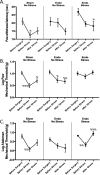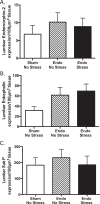Impact of Psychological Stress on Pain Perception in an Animal Model of Endometriosis
- PMID: 28093054
- PMCID: PMC5933089
- DOI: 10.1177/1933719116687655
Impact of Psychological Stress on Pain Perception in an Animal Model of Endometriosis
Abstract
Purpose: Pain in patients with endometriosis is considered a significant source of stress but does not always correlate with severity of the condition. We have demonstrated that stress can worsen endometriosis in an animal model. Here, we tested the impact of a psychological stress protocol on pain thresholds and pain receptors.
Methods: Endometriosis was induced in female rats by suturing uterine horn tissue next to the intestinal mesentery. Sham rats had sutures only. Rats were exposed to water avoidance stress for 7 consecutive days or handled for 5 minutes (no stress). Fecal pellets and serum corticosterone (CORT) levels were measured as an index of anxiety. Pain perception was assessed using hot plate and Von Frey tests. Substance P, enkephalin, endomorphin-2, Mu opioid receptor (MOR), and neurokinin-1 receptor expression in the spinal cord were measured by immunohistochemistry.
Results: Fecal pellets and CORT were significantly higher in the endo-stress (ES) group than endo-no stress (ENS; P < .01) and sham-no stress groups (SNS; P < .01). The ES rats had more colonic damage ( P < .001 vs SNS; P < .05 vs ENS), vesicle mast cell infiltration ( P < .01 vs ENS), and more severe vesicles than ENS. The ES developed significant hyperalgesia ( P < .05) but stress reversed the allodynic effect caused by endo ( P < .001). The MOR expression was significantly reduced in ENS versus SNS ( P < .05) and more enkephalin expression was found in endo groups.
Conclusion: Animals subjected to stress develop more severe symptoms but interestingly stress seems to have beneficial effects on abdominal allodynia, which could be a consequence of the stress-induced analgesia phenomenon.
Keywords: endometriosis; opioids; pain; stress.
Conflict of interest statement
Figures






Similar articles
-
Environmental Manipulations as an Effective Alternative Treatment to Reduce Endometriosis Progression.Reprod Sci. 2018 Sep;25(9):1336-1348. doi: 10.1177/1933719117741374. Epub 2017 Nov 14. Reprod Sci. 2018. PMID: 29137551 Free PMC article.
-
Impact of physical activity on pain perception in an animal model of endometriosis.J Endometr Pelvic Pain Disord. 2015 Jul-Sep;7(3):89-114. doi: 10.5301/je.5000231. Epub 2015 Dec 24. J Endometr Pelvic Pain Disord. 2015. PMID: 28217664 Free PMC article.
-
Stress management affects outcomes in the pathophysiology of an endometriosis model.Reprod Sci. 2015 Apr;22(4):431-41. doi: 10.1177/1933719114542022. Epub 2014 Jul 11. Reprod Sci. 2015. PMID: 25015902 Free PMC article.
-
Stress exacerbates endometriosis manifestations and inflammatory parameters in an animal model.Reprod Sci. 2012 Aug;19(8):851-62. doi: 10.1177/1933719112438443. Epub 2012 Apr 23. Reprod Sci. 2012. PMID: 22527982 Free PMC article.
-
μ-Opioid receptor inhibition of substance P release from primary afferents disappears in neuropathic pain but not inflammatory pain.Neuroscience. 2014 May 16;267:67-82. doi: 10.1016/j.neuroscience.2014.02.023. Epub 2014 Feb 26. Neuroscience. 2014. PMID: 24583035 Free PMC article.
Cited by
-
Endometriosis and Opioid Receptors: Are Opioids a Possible/Promising Treatment for Endometriosis?Int J Mol Sci. 2023 Jan 13;24(2):1633. doi: 10.3390/ijms24021633. Int J Mol Sci. 2023. PMID: 36675147 Free PMC article. Review.
-
The Unmet Needs for Studying Chronic Pelvic/Visceral Pain Using Animal Models.Biomedicines. 2023 Feb 24;11(3):696. doi: 10.3390/biomedicines11030696. Biomedicines. 2023. PMID: 36979674 Free PMC article. Review.
-
Environmental Manipulations as an Effective Alternative Treatment to Reduce Endometriosis Progression.Reprod Sci. 2018 Sep;25(9):1336-1348. doi: 10.1177/1933719117741374. Epub 2017 Nov 14. Reprod Sci. 2018. PMID: 29137551 Free PMC article.
-
Efficacy of an environmental enrichment intervention for endometriosis: a pilot study.Front Psychol. 2023 Oct 10;14:1225790. doi: 10.3389/fpsyg.2023.1225790. eCollection 2023. Front Psychol. 2023. PMID: 37885745 Free PMC article.
-
Peritoneal endometriosis induces time-related depressive- and anxiety-like alterations in female rats: involvement of hippocampal pro-oxidative and BDNF alterations.Metab Brain Dis. 2019 Jun;34(3):909-925. doi: 10.1007/s11011-019-00397-1. Epub 2019 Feb 23. Metab Brain Dis. 2019. PMID: 30798429
References
-
- Bulun SE. Endometriosis. N Engl J Med. 2009;360(3):268–279. - PubMed
-
- McKinnon B, Bersinger N, Wotzkow C, Mueller MD. Endometriosis-associated nerve fibers, peritoneal fluid cytokine concentrations, and pain in endometriotic lesions from different locations. Fertil Steril. 2012;97(2):373–380. - PubMed
-
- Practice Committee of the American Society for Reproductive Medicine. Endometriosis and infertility: a committee opinion. Fertil Steril. 2012;98(3):591–598. - PubMed
-
- Levy BS, Apgar BS, Surrey ES, Wysocki S. Endometriosis and chronic pain: a multispecialty roundtable discussion. J Fam Pract. 2007;56(3 suppl diagnosis):S15–S20. - PubMed
Publication types
MeSH terms
Substances
Grants and funding
LinkOut - more resources
Full Text Sources
Other Literature Sources
Medical
Research Materials

